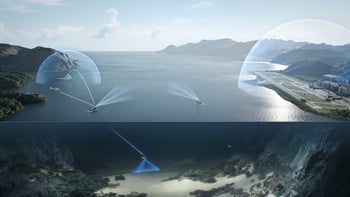
Surveillance and monitoring
Watching over infrastructure that can’t be watched
Critical infrastructure is increasingly remote, submerged and invisible to conventional monitoring. Whether it’s a gas line on the seabed or a cable traversing international waters, these assets require long-term surveillance – not occasional visits. Kongsberg’s maritime monitoring systems are designed to close that gap, offering persistent, layered coverage across vast distances and challenging environments.

Autonomous systems that never stop
At the centre of this capability are long-range autonomous platforms like the HUGIN autonomous underwater vehicle (AUV), capable of patrolling up to 2,200 kilometres per mission and operating at depths down to 6,000 metres. Combined with seabed sensors, hydroacoustic systems and satellite inputs, they create a surveillance net that can detect changes, track threats and identify degradation over time. These technologies operate with minimal human input, significantly reducing cost and exposure while increasing reliability.
Monitoring that informs and protects
Data collected during missions is processed using AI and visualisation tools that highlight anomalies, changes in infrastructure condition and potential indicators of interference. Alerts can be set for specific geofenced areas or patterns of behaviour, ensuring proactive risk management. The same system architecture supports both short-term tactical missions and long-term asset monitoring strategies. Whether the focus is on security, environmental compliance or operational continuity, the result is the same: a clearer picture, with fewer blind spots.